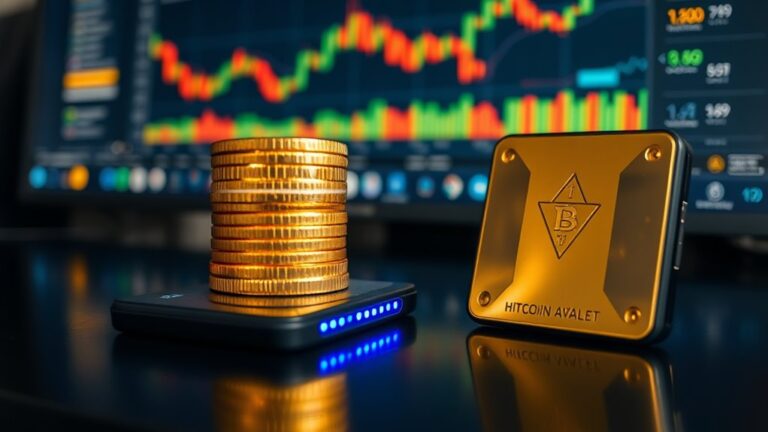What Records All Transactions in a Blockchain?
Note: This post may contain affiliate links, and we may earn a commission (with No additional cost for you) if you purchase via our link. See our disclosure for more info. The gold and crypto world is constantly changing. This is not financial, investment, legal, or professional advice. So, please verify the information on the gold and cryptocurrency provider’s websites.
All those transactions? Yeah, they're logged in a nifty little thing called a decentralized ledger. Imagine it as a public record that's permanent and untouchable—kind of like that embarrassing photo your friend still has from high school. Each transaction is bundled with cryptographic hashes to stay secure. Once it's in there, good luck trying to change it. Curious to know what else goes into this digital treasure chest? Stick around for more juicy details.

Now, every transaction has a structure. Inputs are the sources of funds, like your wallet, while outputs are the recipients—think of them as the lucky people getting your cash. And guess what? Each transaction comes with a cryptographic signature that validates ownership. No signature? No party.
Then we have cryptographic hashes, those magical strings of numbers and letters that keep everything secure. They're like the fingerprints of each transaction, created through algorithms like SHA-256. You could say these hashes are the bouncers of the blockchain dance floor, making sure only valid transactions get in. These cryptographic techniques create a trustless environment where security is maintained without requiring trust in intermediaries.
Cryptographic hashes are the dance floor's bouncers, ensuring only valid transactions groove their way into the blockchain party.
Speaking of validation, transactions are broadcast to the network. Nodes—those computers chugging away—validate each transaction, checking if the sender really owns the funds and ensuring no funny business is happening. Once a transaction passes the sniff test, it's grouped into blocks, hashed, and linked to previous blocks. It's like building a chain made of concrete. This entire process contributes to the blockchain's decentralized ledger-based system. Furthermore, confirmed transactions are irreversible and immutable, ensuring that they remain a permanent part of the blockchain.
Finally, these verified blocks are added to the blockchain. Each block contains transaction data and headers connecting back to earlier blocks. The entire system relies on consensus mechanisms like Proof of Work or Proof of Stake.
Frequently Asked Questions
How Does Blockchain Ensure Transaction Security?
Blockchain secures transactions like a digital fortress. It uses cryptographic hash functions to create unique IDs—like fingerprints for data.
Digital signatures? They authenticate transactions without revealing who's behind them.
And let's not forget about consensus mechanisms. They keep everything in check, with methods like Proof of Work and Proof of Stake.
Once a transaction is recorded, good luck changing it. Tampering? Almost impossible.
What Happens if a Transaction Is Incorrect?
When a transaction goes haywire in blockchain, it can lead to chaos.
Incorrect transactions can be flagged, but good luck trying to reverse them. Once it's on the chain, it's pretty much permanent.
Wallets might suffer losses, and users can end up scratching their heads, wondering what happened.
No magical undo button exists. The decentralized nature means no single authority to fix mistakes.
Can Blockchain Transactions Be Reversed?
Can blockchain transactions be reversed? Nope. Once they're confirmed, they're stuck there, like that awkward moment you can't escape.
The system is designed to be unchangeable. You can't just hit ‘undo' like in your word processor.
Sure, there are ways to tinker with unconfirmed transactions, but that's a whole different ballgame.
In the end, confirmed transactions are as permanent as that bad tattoo you regret. Good luck with that!
How Are Transactions Verified Before Recording?
Before anything hits the blockchain, transactions go through a rigorous vetting process.
First, nodes in the network check if the sender has enough funds and valid digital signatures. Then, they group these transactions into blocks. Sounds fancy, right?
But it's not just for kicks; consensus mechanisms like Proof-of-Work or Proof-of-Stake guarantee everyone agrees on what's legit. If it passes all that scrutiny, it gets a shiny new home on the blockchain.
What Technology Underlies Blockchain Transaction Records?
Blockchain transaction records rely on a web of tech wizardry.
Think blocks, crammed with transaction details, linked together like a digital chain gang. It's all about that distributed ledger—no single boss keeping tabs.
Cryptography? Oh yeah, it's the backbone, ensuring data stays locked up tight.
And consensus mechanisms? They're like the world's most nerdy referee, making sure everyone agrees before anything gets written down.
Trust issues? Not here. It's all about transparency and security.













One Comment